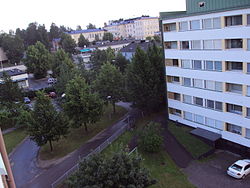Suburb
A suburb (or suburban area or suburbia) is a commercial, mixed-use or residential area.[1][2] It can exist either as part of a city/urban area and can often have a large degree of employment.[3][4] In some metropolitan areas they exist as separate residential communities within commuting distance of a city. Suburbs might have their own political or legal jurisdiction, especially in the United States, but this is not always the case, especially in the United Kingdom where most suburbs are located within the administrative boundaries of cities.[5] In most English-speaking countries, suburban areas are defined in contrast to central or inner city areas, but in Australian English and South African English, suburb has become largely synonymous with what is called a "neighborhood" in other countries, and the term encompasses inner city areas.[citation needed]


In some areas, such as Australia, India, China, New Zealand, Canada, the United Kingdom, and parts of the United States, new suburbs are routinely annexed by adjacent cities due to urban sprawl. In others, such as Morocco, France, and much of the United States, many suburbs remain separate municipalities or are governed locally as part of a larger metropolitan area such as a county, district or borough. In the United States, regions beyond the suburbs are exurbs or "exurban areas", with less population density (but still more than rural areas) but linked to the metropolitan area economically, particularly by commuters.
Suburbs first emerged on a large scale in the 19th and 20th centuries as a result of improved rail and road transport, which led to an increase in commuting.[6] In general, they are less densely populated than inner city neighborhoods within the same metropolitan area, and most residents routinely commute to city centers or business districts via private vehicles or public transits; however, there are many exceptions, including industrial suburbs, planned communities and satellite cities. Suburbs tend to proliferate around cities that have an abundance of adjacent flat land.[7]
References
- ↑ "Strip Mall Plans".
- ↑ "Types of Zoning".
- ↑ "Why more people are commuting from cities to suburbs". Us.jll.com. 25 June 2018.
- ↑ "Suburbs (Continue to) Dominate Jobs and Job Growth". Newgeography.com. Retrieved 12 December 2021.
- ↑ Caves, R. W. (2004). Encyclopedia of the City. Routledge. p. 640. ISBN 9780415252256.
- ↑ Hollow, Matthew (2011). "Suburban Ideals on England's Interwar Council Estates". Journal of the Garden History Society. Retrieved 29 December 2012.
- ↑ The Fractured Metropolis: Improving the New City, Restoring the Old City, Reshaping the Region by Jonathan Barnett, via Google Books.



